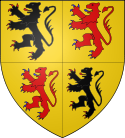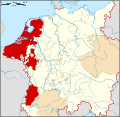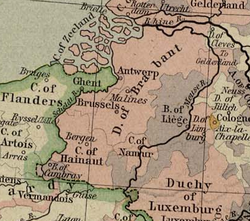- County of Hainaut
-
County of Hainaut
Grafschaft Hennegau (de)
Comté de Hainaut (fr)
Graafschap Henegouwen (nl)State of the Holy Roman Empire ← 
←
←
1071–1794  →
→

Later coat of arms Original coat of arms Historical map of the duchy of Brabant, the county of Hainaut and the Prince-Bishopric of Liège (1477). Mons, the capital of Hainaut is shown with its Dutch name, Bergen. Capital Mons Language(s) French, Dutch, German, Walloon Religion Roman Catholicism Government Principality Count - ? –898 Reginar I
(first Reginar count)- 1071–98 Baldwin II - 1432–67 Philip the Good, Duke of Burgundy - 1477–82 Mary of Burgundy - 1792–94 (died 1835) Francis II, Holy Roman Emperor (last count) Historical era Middle Ages - Consolidation of county 1071 - Acquired by Burgundy 1432 - Absorbed into
Habsburg Netherlands
18 August 1477- Joined Burgundian Circle 1512 - Annexed by France 1794 - Treaty of Campo Formio 1797 - This article deals with the historical county of Hainaut, for other meanings see Hainaut (disambiguation).
The County of Hainaut (French: Comté de Hainaut, Dutch: Graafschap Henegouwen) was a historical region in the Low Countries with its capital at Mons (Bergen). In English sources it is often given the archaic spelling Hainault.
It consisted of what is now the Belgian province of Hainaut and the southern part of the French département Nord. In Roman times, Hainaut was situated in the Roman provinces of Belgica and Germania Inferior and inhabited by Celtic tribes, until Germanic peoples replaced them and ended Roman Imperial rule. Its most important cities were Mons (Bergen), Cambrai (Kamerijk) and Charleroi. Today the historic county of Hainaut is territorially divided between Belgium and France.
History
The County of Hainaut (pronounced: ĕ nō') arose about 900 in the Lotharingia region, when Duke Reginar I of Lorraine, a grandson of Frankish Emperor Lothair I, appeared as a "Count of Hainaut". After the death of the last Carolingian king in East Francia, Louis the Child in 911, Reginar joined the West Frankish realm under King Charles the Simple. His son and successor Duke Gilbert in 925 in turn submitted himself to the German king Henry the Fowler, whereafter the Duchy of Lotharingia remained a part of the German kingdom at the border with France.
After Gilbert's death in 939 his successors from the House of Reginar failed to retain the ducal title, but ruled over the Hainaut region until in 958 Count Reginar III Longneck, after he had revolted against Duke Bruno the Great, was deposed and banned. The county was then divided, however in 998 the Reginars regained the rule over the County of Mons. When the last Count, Herman, died without issue in 1051, his widow Richilde married Baldwin VI, the eldest son of Baldwin V, the Count of Flanders and vassal of the French crown. Upon the death of his father in 1067, Baldwin VI became the ruler of both counties, succeeded by his son Arnulf III who died in an inheritance conflict with his uncle Robert I the Frisian at the 1071 Battle of Cassel.
While victorious Robert acquired Flanders, his sister-in-law Richilde retained the adjacent Lower Lorraine territories in the Holy Roman Empire as her dowry. Therebey the renewed County of Hainaut emerged from the refeudalisation of three immediate counties:
- the County of Mons
- the southern part of the Landgraviate of Brabant
- the Ottonian Margraviate of Valenciennes
The unification of the County of Hainaut as an Imperial fief was accomplished in 1071, when Richilde and her son Baldwin II after Arnulf's defeat tried to sell their fiefs to Emperor Henry IV. Henry IV ordered the Prince-Bishop of Liège to purchase the fiefs and then return them as a unified county to the countess Richilde and under feudal intermediance to the Dukes of Lower Lorraine.
The Counts of Hainaut had several historical connections with the counts of Flanders and Holland, to whom they had strong family ties. Throughout its history, the county of Hainaut formed a personal union with other states, e.g.:
- Hainaut and Flanders: 1067–71 and again 1191–1246
- Hainaut and Holland: 1299–1436
- Hainaut and Bavaria-Straubing: 1356–1417
After the death of Duke William II of Bavaria-Straubing in 1417, Hainaut was inherited by his daughter Jacqueline (Jacoba), who in 1432 had to cede the county together with Holland to Duke Philip the Good from the House of Valois-Burgundy. The last independent countess died early on 8 October 1436 (presumably of tuberculosis) in Teylingen Castle, near The Hague (where she is buried), her estates were incorporated into the Burgundian Netherlands.
When Charles the Bold was killed at the 1477 Battle of Nancy, the male line of the Burgundian dukes became extinct. In the same year Charles' daughter Mary of Burgundy however married Archduke Maximilian I of Habsburg, the son of Emperor Frederick III. Maximilian rejected the claims of Charles' cousin King Louis XI of France at the 1479 Battle of Guinegate and Hainaut became a part of the Habsburg Netherlands by the Treaty of Arras in 1482, and of the Spanish Netherlands from 1556. In 1579 Hainaut was a member of the Union of Arras which submitted to the rule of Habsburg Spain, while the northern Union of Utrecht formed the Dutch Republic in 1581.
By the 1659 Treaty of the Pyrenees and the 1679 Treaties of Nijmegen the southern part around the town of Valenciennes fell to France under King Louis XIV. The northern area around Mons was incorporated into the Austrian Netherlands after the extinction of the Spanish Habsburgs according to the 1713 Treaty of Utrecht. It was ruled by the Habsburg Emperors, the last one Francis II, until in 1794 the Austrian Netherlands were occupied by the French First Republic in 1794.
See also
- Gautier le Leu, thirteenth-century poet possibly from Hainault
- Counts of Hainaut
- Countesses of Hainaut
- Counts of Hainaut family tree
- Counts of Holland family tree
 Burgundian Circle (1512–1806) of the Holy Roman EmpireRemained
Burgundian Circle (1512–1806) of the Holy Roman EmpireRemained
County Imperial City Besançon3Dependent territories Categories:- Former principalities
- Former polities in the Netherlands
- States of the Holy Roman Empire
- States and territories established in 1071
- States and territories disestablished in 1794
- Counts of Hainaut
- County of Hainaut
- Seventeen Provinces
- Burgundian Circle
- 1794 disestablishments
- States and territories established in the 9th century
- Counties of the Holy Roman Empire
Wikimedia Foundation. 2010.

